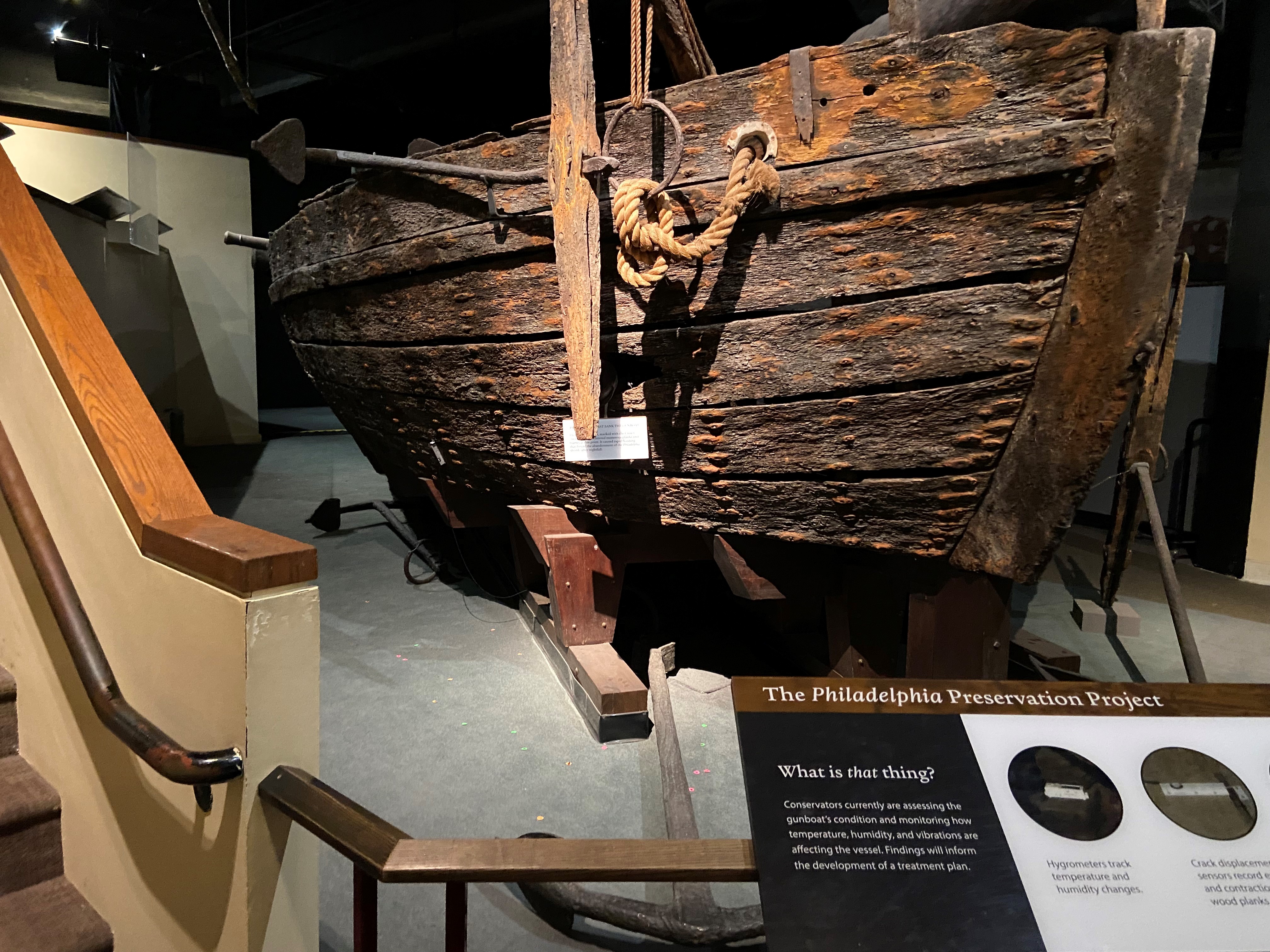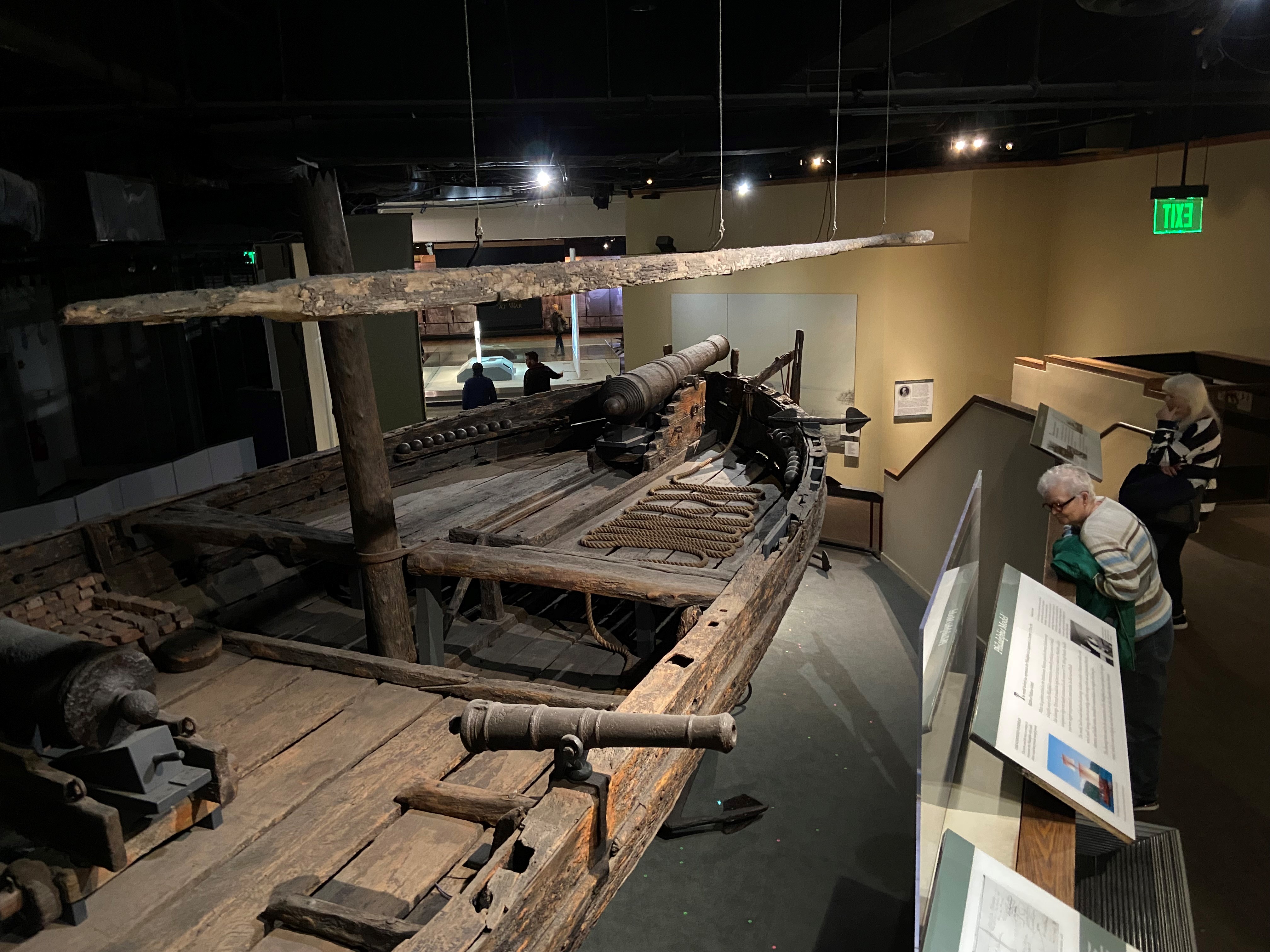Preservation Periodical: Volume 3, Issue 2
Summer 2024
Gunboat Philadelphia Receives a Save America’s Treasures Grant
By Carly Bond
There are countless inestimable objects within the Smithsonian Institution’s collections. Two objects within the Institution are additionally designated National Historic Landmarks: the U.S. Continental Gondola Philadelphia and the Saturn V.[i] There are only approximately 2,600 National Historic Landmarks in the United States; this special historic designation is identified for historic properties that have exceptional value in illustrating or commemorating aspects of American history and culture. You may be most familiar with designating buildings as National Historic Landmarks, of which the Smithsonian has four such designations[ii], but this distinction is also granted to sites, structures, objects, and districts.
The U.S. Continental Gondola Philadelphia, also known as the gunboat Philadelphia, was moved to the National Museum of American History in 1961. American History’s collection contains many large objects, including the Philadelphia, that had to be placed inside the museum during construction for their exhibition when the museum opened in 1964. It was declared a National Historic Landmark in 1961 for its association with the War for Independence, as the only surviving gunboat built and manned by American forces during the Revolutionary War.
Originally constructed in the summer of 1776 in upstate New York, the Philadelphia was one of 8 gunboats in unit with fifteen small crafts which Benedict Arnold used to engage heavier British vessels in the battle of Valcour Island, Lake Champlain on October 11, 1776. This battle is credited for diverting the British from advancing on Ft. Ticonderoga, and allowed the new American military to strengthen, leading to the eventual American victory at Saratoga in September and October 1777. This victory proved to be a turning point in the American struggle for Independence, having defeated a superior British army, it helped to secure French support needed to win the war.
The gunboat sank on the first day of the battle, on October 11, 1776, from three cannon shot holes in the hull, and was recovered with a British cannon ball still lodged in its hull. Recovered in 1935, 57 feet below the surface of Lake Champlain, the Philadelphia was well preserved by the cold water. The gunboat’s oak hull (54 feet in length, 15 feet in beam, and 5 feet deep), mast (36 feet high), and three guns (one twelve-pounder and two nine-pounders) were recovered mostly intact. Hundreds of other objects were recovered from the 44 men that operated the gunboat, including ammunition, tools, cooking utensils, and buttons, exhibited in and along side the gunboat.
This national treasure received a Save America’s Treasures grant; a program used to help preserve premier American cultural resources. This matching grant program started in 1998 and has since awarded more than 1,300 grants totaling more than $300 million to nationally significant resources across the nation. The National Park Service administers the Save America’s Treasures grant program in partnership with the National Endowment for the Arts, National Endowment for the Humanities, and the Institute of Museum and Library Services
Award of the Save America’s Treasures grant to the Philadelphia Preservation Project assists with conservation work to be completed in 2026, America’s 250th anniversary year. Conserving the Philadelphia to coincide with the commemoration of the 250th anniversary is a fitting end to its origin story as the only surviving accessible American gunboat built and manned by American forces during the Revolutionary War.
The Philadelphia will be conserved in place on the third floor of the National Museum of American History, protected by temporary conservation space constructed around it with viewing windows. Conservation work is expected to occur between March 2025 and June 2026. If you visit the National Museum of American History next year, visit the gunboat Philadelphia and observe the conservation work to be a part of this monumental event.
[i] The Saturn V rocket is one of three in the world, located at the U.S. Space and Rocket Center in Huntsville, Alabama.
[ii] Four of the Smithsonian’s buildings are designated National Historic Landmarks: the Smithsonian Institution Building, the Arts & Industries Building, the Renwick Gallery, and the Andrew Carnegie Mansion.


[i] The Saturn V rocket is one of three in the world, located at the U.S. Space and Rocket Center in Huntsville, Alabama.
[ii] Four of the Smithsonian’s buildings are designated National Historic Landmarks: the Smithsonian Institution Building, the Arts & Industries Building, the Renwick Gallery, and the Andrew Carnegie Mansion.